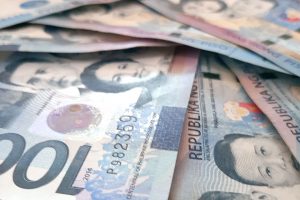




Monthly Economic Update: One for the road
 DOWNLOAD
DOWNLOAD

Inflation Update: Still low, still slow
 DOWNLOAD
DOWNLOAD

Philippines Trade Update: Exports momentum continues
 DOWNLOAD
DOWNLOAD


Debt service bill more than doubles in March

The National Government’s (NG) debt service bill more than doubled in March from a year ago, data from the Bureau of the Treasury (BTr) showed.
The government’s debt payments surged by 111% to PHP 142.171 billion in March from PHP 67.389 billion in the same month a year ago.
Month on month, debt service payments fell by 62.2% from PHP 375.714 billion in February.
In March, more than half or 57.17% of debt servicing went to amortization.
Overall principal payments jumped by more than sixfold to PHP 81.273 billion from PHP 11.841 billion in the same month a year ago.
The BTr settled PHP 73.361 billion with domestic lenders and PHP 7.912 billion to foreign creditors.
Meanwhile, interest payments rose by 9.6% to PHP 60.898 billion in March from PHP 55.548 billion in the same month in 2022.
Broken down, interest paid on domestic debt slipped by 1.22% to PHP 46.754 billion from PHP 47.332 billion last year.
Domestic debt consisted of PHP 25.62 billion in retail Treasury bonds, PHP 19.671 billion in fixed-rate Treasury bonds, and PHP 1.435 billion in Treasury bills.
Interest on foreign debt increased by 72.2% to PHP 14.144 billion from PHP 8.216 billion a year ago.
For the first quarter, debt service payments surged by 80.4% to PHP 565.716 billion from PHP 313.65 billion a year ago.
Principal repayments made up three-fourths (74.9%) of the debt service bill in the January-to-March period.
Amortization payments climbed by 157.9% to PHP 423.739 billion in the first quarter.
Total interest payments went down by 4.9% to PHP 141.977 billion in the first three months from PHP 149.329 billion in the same period last year.
ING Bank N.V. Manila Senior Economist Nicholas Antonio T. Mapa said that the rise in debt servicing in March can be attributed to higher borrowing costs.
“Higher debt stock plus higher interest rates contributed to this after global central banks hiked rates aggressively over the past few months,” Mr. Mapa said in a Viber message.
Since March last year, the US Federal Reserve raised borrowing costs by 500 basis points (bps), bringing the Fed funds rate to 5-5.25%.
The Bangko Sentral ng Pilipinas raised key interest rates by a total of 425 basis points to 6.25% since May 2022.
“This is consistent with the higher budget deficit during the month amid higher inflation and higher interest rates that increased the government’s interest expenses and borrowing costs,” Rizal Commercial Banking Corp. Chief Economist Michael L. Ricafort said in a Viber message.
In March alone, the budget deficit widened by 12.04% to PHP 210.3 billion from PHP 187.7 billion a year ago, driven by a decline in spending and revenues.
Headline inflation averaged 8.3% in the first three months, well above the central bank’s revised 5.5% full-year forecast and 2-4% target range.
“The weaker peso exchange rate versus the US dollar year on year also increased the debt servicing of US dollar and other foreign currency-denominated debts,” Mr. Ricafort added.
For 2023, the government programmed debt payments to reach P1.6 trillion, 23.3% higher than last year’s PHP 1.298-trillion program.
In 2022, actual debt service payments reached PHP 1.293 trillion, up by 7.4% year on year.
The government borrows from external and local sources to fund a budget deficit capped at 6.1% of gross domestic product (GDP) this year.
The National Government’s total outstanding debt reached PHP 13.91 trillion at the end of April.
Credit rating
Meanwhile, Finance Secretary Benjamin E. Diokno said that it is “possible” for the Philippines to secure the coveted “A” rating from credit watchers by 2028.
“We’re getting there… For example, we have an ‘A’ rating from the Japan Credit Rating Agency (JCR)… If you look at the rest of the world, around a third were downgraded. But we are doing okay. (We are still) on the road to ‘A,’” he said in mixed English and Filipino during a press chat on Friday.
In March, the JCR maintained the country’s credit rating at “A-” with a stable outlook.
Meanwhile, Fitch Ratings kept its long-term foreign currency issuer default rating at “BBB” for the Philippines in May, while S&P Global Ratings affirmed its “BBB+” in November last year.
Moody’s Investors Service also kept the Philippines’ “Baa2” credit rating with a stable outlook in September last year.
In 2021, China Lianhe Credit Rating Co. maintained its “AAA” credit rating with a stable outlook.
To achieve an A-level investment grade, Mr. Diokno said that the government must continue its fiscal consolidation plans and improve spending on infrastructure.
“(In the previous) years, we only spent 2-3% of gross domestic product (GDP) on infrastructure. Now, we ramped it up to 5-6% of GDP,” he said.
This year, the government plans to spend 5.3% of GDP on infrastructure, equivalent to PHP 1.29 trillion. — By Luisa Maria Jacinta C. Jocson, Reporter
This article originally appeared on bworldonline.com





 By BusinessWorld
By BusinessWorld